Faced with the problem of fistula on the gums and not able to quickly get to the dental office, patients are wondering: how to treat a fistula at home, is it dangerous and can it go away on its own.
Before answering these questions, it is worthwhile to understand in more detail what kind of disease it is and what causes it.
Fistula on the gums is a disease of an inflammatory purulent nature. The fistula itself, in fact, is a kind of channel that connects the epicenter of inflammation with the surface. First, there is an internal focus of the disease, the development of which is accompanied by suppuration processes. When in this focus the purulent mass reaches a certain critical amount, it looks for a way out and forms the fistula itself. Due to this characteristic, it is sometimes called "fistula", "tube" in Latin.
Causes of a fistula on the gum
As already noted, the disease does not appear for no reason, by itself. As a rule, it is a consequence of other problems and diseases. oral cavity:
- Caries (rotting of hard dental tissue);
- Pulpitis (complications after untreated caries, when suppuration processes affect the tissues of the core of the tooth);
- Periodontitis (inflammatory disease of the tissues surrounding the tooth).
Why does a fistula form after these diseases? The fact is that when the liquids that are created in the process of suppuration cannot find their way out (due, for example, to poor cleaning of the affected area of the tooth and poor-quality filling, etc.), they create a channel in another place, which is fistula.
Thus, diseases such as caries and pulpitis are not even involved in the appearance of a fistula, but rather their poor-quality treatment.
Often the cause of a fistula is milk teeth and wisdom teeth, which grow with some defects, or very slowly. At the same time, the shell around such "problem" teeth becomes inflamed and the products of suppuration also look for a way out, forming a disease.
Symptoms
There are several obvious signs the appearance of a fistula on the gums, however accurate diagnosis can only be installed by a specialist.
It is worth noting that individually these symptoms do not mean the presence of the disease, its existence can only be judged if all or most of them are present.
- Pain in the gums after mechanical impact on it (for example, pressing). This means that there is an inflammatory process, if you have not damaged the gum before eating;
- The appearance on the gum of a zone that stands out with obvious redness, pus or a liquid similar to it may ooze from it;
- The tooth, near which a fistula occurs, can move slightly with a physical impact on his body;
- Sometimes, the temperature of not only the affected area of the gums, but of the whole body may rise. Most often, the indicators stop opposite the thermometer mark of 37-38 degrees.
If the fistula is formed deep on the root of the tooth, then determine it for sure maybe an x-ray.
Types of disease
It goes without saying that such a complex disease has a number of varieties caused by different factors, from the growth of "wisdom" teeth to operations carried out in dental clinic.
Separately, it is worth highlighting the following types:
- Fistula after tooth extraction - the process of resection (removal) of a problem tooth can cause a fistula due to suppuration processes in the sinuses, gum tissue or jaw. It should be noted right away that it does not occur very often. A fistula may be the result of infection during the operation itself. Also, the place where the tooth was removed has little resistance to the formation of a fistula from foci of inflammation located under other teeth located nearby.
- Severe complication after tooth extraction upper jaw may be the appearance of a fistula from the diseased area in the mouth to maxillary sinuses, resulting in inflammation of the latter.
- , which is a suppuration in the form of a capsule, and he also needs to find his way out through the fistula, although this does not always happen. Then, surgical intervention and opening of the inflamed zone is necessary. As a rule, the disease manifests itself in the form of gum outflow of impressive size. The same applies to diseases such as granuloma. Interestingly, the latter is treated by creating an "artificial" fistula, that is, they are pierced, allowing the fluid to come out.
- Fistula under the crown - occurs quite often. After complex and frequent procedures according to the establishment of crowns, the formation of a fistula is quite likely, it occurs as a result of non-healing of the dental canals, which leads to their subsequent inflammation. The situation is very complicated by the fact that a person then has already installed crowns, and they have to be removed for complete treatment problem area. In addition, it is necessary to take an x-ray, because otherwise it is extremely difficult to diagnose this type of fistula in the mouth.
- Fistula after implantation of a tooth - as in the case of a crown, a fistula after implantation occurs as a result of improper cleaning of the place where the implant is installed or its incorrect installation. In this case, the affected area requires an x-ray and a course of treatment, which is complicated by the presence of an already installed implant.
Photo and x-ray
In fact, all fistulas are purulent in nature and look like in this photo.
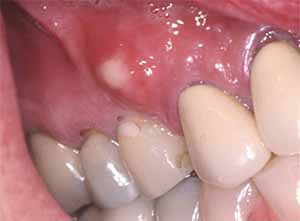
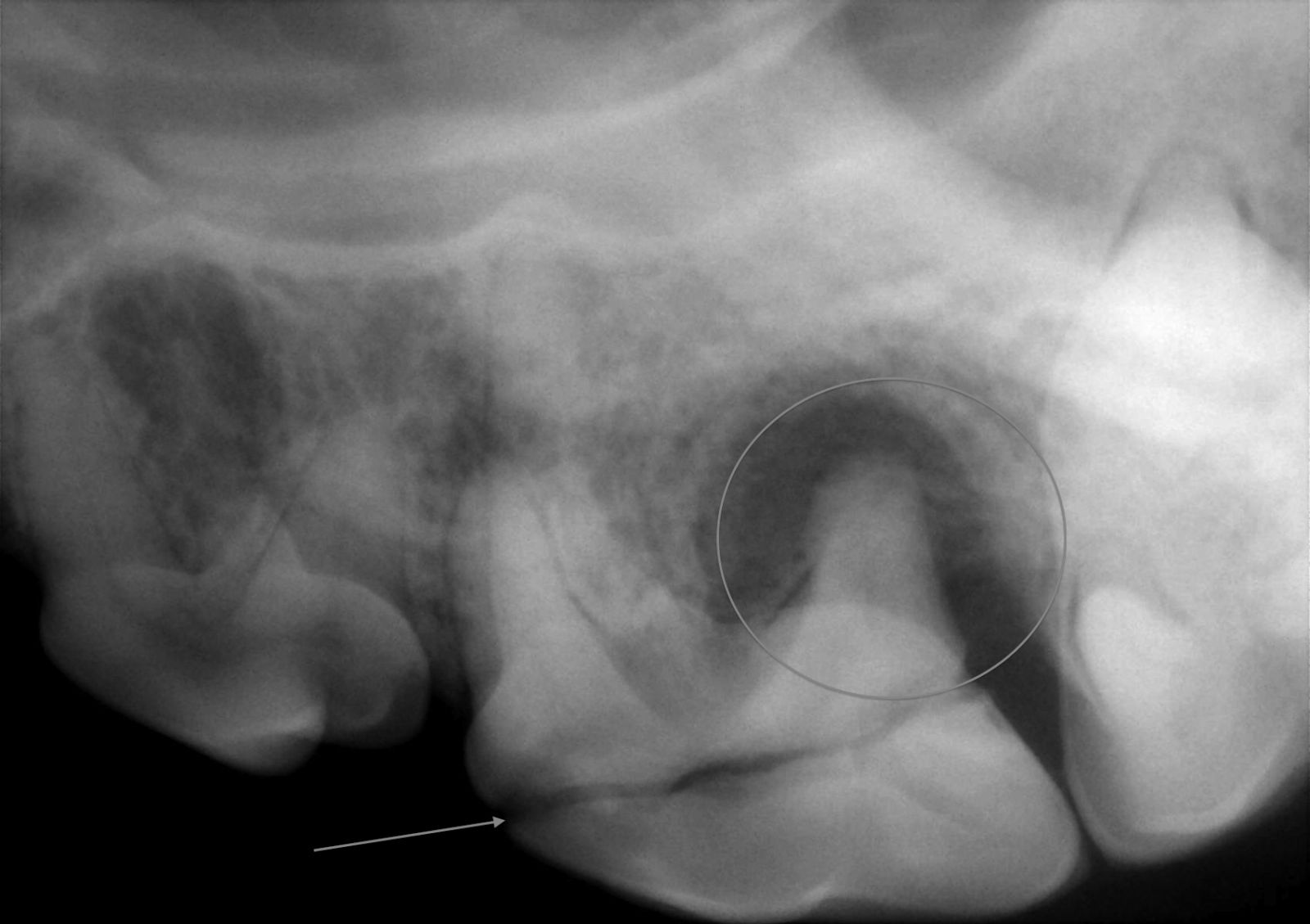
Methods of treatment
It should be noted right away that the treatment of a fistula on the gums is a rather complicated process and requires integrated approach, consultation of the dentist and his intervention.
The dentist can open problem area, put drainage there for the outflow of pus, etc. If crowns, fillings, implants, etc. interfere with the treatment, the doctor can remove them.
Antibiotics
As already noted, the treatment of fistula with antibiotics is an auxiliary measure, while dental operations are considered the main ones.
However, a properly selected course of antibiotics can effectively contribute to the treatment process. In this case, antibiotics can be taken both in the form of tablets and by injection.
folk methods
This method can be used to limit the spread of infection, relieve pain in the affected area, however, alternative methods should be used only after consulting a doctor and in parallel with the measures prescribed by him.
Since there are many herbs in nature, the action of which is comparable to the action of antibiotics, it is appropriate to use them in this case.
How to treat fistula in adults?
- Treatment of the main causes of fistula - the dentist eliminates flaws in the teeth, heals caries, pulpitis, periodontitis and other diseases that cause fistula on the gums.
- Drug treatment - antibiotics prescribed by a doctor, antibacterial gels and pastes are used, which are rubbed into sore spot. Possible reception antihistamines etc.
- Dental operations to remove the fistula - if the affected area is under a filling or crown, then it is quite possible to remove them with subsequent treatment of the sore spot. Incisions and drainage are also used for this.
- Treatment folk methods at home - the use of the above decoctions of herbs and tinctures to limit the effects of infection, pain relief and disease prevention.
Fistula treatment during pregnancy
Since the body of a pregnant woman is extremely susceptible to different kind infections and diseases, then there are also fistulas on the gums, although it is worth noting that this does not happen too often.
Of course, in this case, it is not necessary to treat the fistula with antibiotics. When pregnant, be sure to visit the dentist, who will take surgical measures and prescribe herbal preparations, most often in the form of ointments.
Also, you can use decoctions of eucalyptus and calendula. To do this, you need to rinse your mouth with an emphasis on the affected area. Such funds will help to avoid surgical intervention, which is also not very desirable during pregnancy.
Treatment of a fistula in children on the gum of a milk tooth
In children, the occurrence of fistulas on the gums is often observed. This is primarily due to impaired growth of milk teeth, which leads to suppuration in soft tissues.
For a child's fragile body, this situation poses a serious threat, on the basis of which one should not neglect a visit to the dentist and thorough treatment.
Undertreatment fistula in babies can lead to a general weakening of the body, irritation and suffering of the child due to toothache, the ingress of purulent products into the esophagus, etc. In addition, a neglected fistula on milk teeth can lead to chronic diseases permanent teeth and peridental tissues.
In fact, there are two main ways:
- Medical treatment with appropriate child's body medicines prescribed by a doctor. Also, you can use different herbal decoctions to fight infection in the child's mouth.
- Removal of a milk tooth that caused a fistula in a child. Such measures are taken when the doctor concludes that the disease is more serious, and medical methods treatments will not give the desired results. After the tooth is removed, the doctor cleans the affected area and prescribes a course of rehabilitation treatment.
Video: what is a fistula (fistula)?
Prevention
Preventive measures to avoid the appearance of a fistula on the gums can be called, first of all, maintaining a healthy atmosphere in the oral cavity. To do this, it is necessary not only to engage in oral hygiene, but also to visit the dentist regularly, to clean the teeth from plaque, tartar, etc.
More than 75% of all fistula diseases occur precisely because of insufficient oral care and untimely treatment of underlying dental diseases.
Baths made from eucalyptus, yarrow and other herbs that have antibacterial properties are perfect for the prevention of fistula.
Perhaps many can say what a dental fistula is, since they have experienced it at least once. Usually, with improper dental treatment or simply a lack of hygiene, a cavity forms in the gum, which is filled with pus. Some try to squeeze out suppurations on their own, without even thinking about what all this can lead to. The resulting tubercle on the gum, this is only outward manifestation a rather serious disease that has to be fought for quite a long time.
If there is a dental fistula, this disease is called periodontitis. This term comes from a similar word - periodontium. Periodontium is a kind of apparatus that attaches the tooth to the bone tissue. Periodontitis in the process of its development can lead to the destruction of the periodontium at the root of the tooth, and then the formation of an abscess in this area, i.e. dental fistula.
Select the desired item:
Causes
Fistulas, according to dentists, are often encountered and very dangerous disease, which is not so easy to cure, it will take a lot of time. And if we talk about the causes of this disease, it is not so easy to establish them. But, as practice shows, 3 main reasons for the formation of a gingival fistula are revealed.

Symptoms
Symptoms are quite pronounced, which are simply impossible to pay attention to.
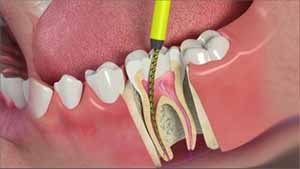
At the first manifestation this disease, you should immediately visit the dentist in order to avoid more serious consequences.
Treatment
Before starting treatment, the doctor takes a picture to fully determine and assess the extent of the disease and determine the size of the fistula in the gum. It is impossible to delay treatment, as the infection will spread deeper and deeper.
Initially, a diseased tooth is treated, the tooth cavity is completely cleaned and it is sealed. Then start drug treatment antibiotics (gentamicin or its analogues), are prescribed 2 ampoules per day intramuscularly for up to 2 weeks.
Antibiotics are combined with antihistamines, usually it is Tavegil, Suprastin or Cetrin, since you should get rid of pathogenic microbes in your mouth. With pronounced pain, the dentist prescribes an analgesic, for example, Ketorol.
In addition, the doctor prescribes salt baths for the fistula area, as well as antibacterial ointments and gels. Dental fistula is treated for a long time, so you have to be patient and visit the dentist regularly. This necessary measure, which should not allow further spread of the infection, since it is possible completely.
It is much more difficult to treat a fistula when the tooth is sealed. Initially, the doctor removes the filling, cleans the tooth canal, treating it with anti-inflammatory and disinfectant solutions, and only then fills the tooth again. After filling processes special paste which will not allow development pathogenic bacteria, which contribute to the formation of ulcers on the gums.
At advanced disease doctor decides on surgery 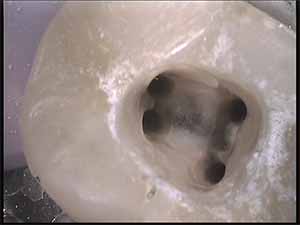 intervention. The operation will be inevitable if the inflammation has touched the periosteum. A qualified specialist, during the operation, will try his best to save the tooth and injure the gum as little as possible. Without surgical intervention also indispensable if noticeable, in other words, this is inflammation at the root of the tooth. At this treatment usually use local anesthesia, to general anesthesia are extremely rare.
intervention. The operation will be inevitable if the inflammation has touched the periosteum. A qualified specialist, during the operation, will try his best to save the tooth and injure the gum as little as possible. Without surgical intervention also indispensable if noticeable, in other words, this is inflammation at the root of the tooth. At this treatment usually use local anesthesia, to general anesthesia are extremely rare.
Ultrasound treatment is often used in the treatment of dental fistula. Ultrasound affects the affected area of the gums, sometimes laser tissue treatment can be applied. Such methods are very effective and are used already in the rehabilitation process.
Prevention
If the treatment is carried out correctly, the fistula will heal fairly quickly and will no longer bother. But one must always be on guard, since everyone who has at least once formed a fistula is at risk of a recurrence of the fistula, only in a different place. Therefore, it is necessary to pay great attention to prevention, and we clearly know that a disease is always easier to prevent than to cure it, so it is enough to know and follow a few rules and you can no longer remember about the fistula.
- Get regular check-ups with your dentist.
- Maintain good oral hygiene.
- Promptly seek medical attention at the first sign of illness.
- Choose a reliable and experienced dentist.
Only with such observance of the rules can the appearance of a dental fistula be avoided, which causes many problems for a person. In addition to prevention, do not forget to clean the plaque and remove tartar once every six months. Eat right, eating foods containing calcium, which not only strengthens the immune system, but also helps prevent the formation of pathogenic microorganisms.
Take care of yourself and your health!
A fistula after tooth extraction is a rather rare form of complication, accompanied, as a rule, by an unrecognized process of decay in the tissues of the gums, jaw or sinus. The fistula is a channel connecting the point of accumulation of pus and the surface of the gums.
Usually, the formation of a fistula can be observed in the oppressed places of the gums, for example, on the surface damaged as a result of tooth extraction. It is through this channel, called the fistula, that the accumulated pus begins to drain into the oral cavity over time under the influence of pressure. However, it is not completely transported. For example, in case of removal upper tooth fistula connects the oral cavity with the sinus of the upper jaw.
The appearance of a fistula, or as it is also called a fistula, indicates that acute or chronic problems occur inside the gums. inflammatory processes.
Sometimes a fistula appears next to the tooth due to poor canal filling. But it also occurs after a poorly performed tooth extraction procedure.
The most common cause of a fistula today is considered to be poor root canal therapy.
Along with these reasons, there are other reasons for the appearance of a fistula:
- tooth extraction procedure, during which the root walls are damaged and infection enters the canal;
- insufficient filling of the canal after endodontic therapy;
- development of cysts at the root tips and their inflammation;
- germination of the wisdom tooth;
- running the process of caries in the teeth or inflammation of the neurovascular bundle of the tooth (pulpitis).
On the initial stage purulent masses begin to accumulate in the wound, which later look for a way out, as a result of which a fistula forms on the gum. This education must be eliminated immediately.
The process of decay can occur in the periodontium, periodontium, gums and maxillary sinuses. Such areas are characterized by the presence of extensible tissues and cavities formed from the tissues of the tooth, gums and the jaw itself.
Often a fistula needs to be re-treated to treat it. root canals(if a fistula appeared near the tooth), or open the gum and clean it if an extraction was performed. This can be done only by contacting the appropriate specialists. If periodontitis has served as a factor in the occurrence of a fistula, then you can treat it at home.
Symptoms of pathology
One of the symptoms of a fistula is the presence of a large number teeth in the oral cavity, prone to carious process and not cured for a long time. Often this process contributes to the development of such a pathology as periodontitis, as a result of which a fistula develops.
However, the main sign of the development of pathology is the appearance of a channel through which purulent masses flow into the oral cavity. Along with this, a small bag appears on the upper part of the gum, in which pus accumulates. If the head of the specified formation has White color, this indicates the neglect of the pathology.
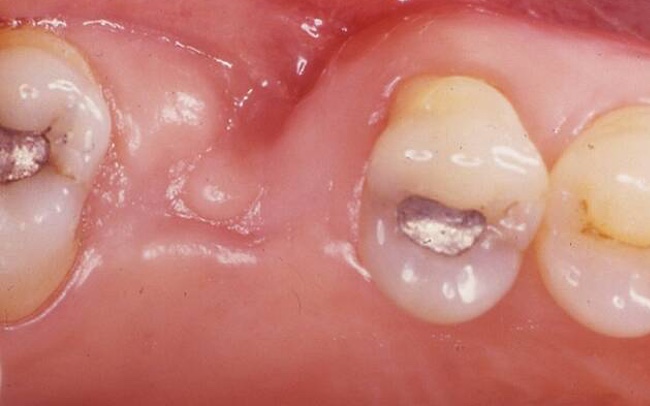
Specialists identify several more symptoms that may indicate the presence of a fistula:
- painful sensations of a pulsating nature, which are aggravated by pressure;
- at the site of the localization of a possible fistula, the gum area has a redder tint;
- the appearance of purulent masses from the point of tooth extraction;
- purulent smell that manifests itself during a conversation with a patient;
- increased body temperature;
- swelling of the gums;
- looseness of the tooth.
If at least one of the above symptoms is detected, you should immediately consult a doctor. After all, if you ignore this process, it can lead to various complications, for example, to osteomyelitis.
Principles of treatment
Before deciding on the treatment process, the doctor takes x-rays to clarify the degree of the disease. Along with this, the picture can indicate the size of the fistula. As noted earlier, it is not recommended to delay the treatment of pathology, since the process develops quickly and penetrates deep into the tissues.
If the patient applied for medical care, then there are chances to cure the problem without surgical intervention. It will also be possible to save the tooth in the absence of infectious process in the periosteal tissue.
At the initial stage of therapy, measures are taken to eliminate the cause of the pathology. As a rule, carious stones deposited on the enamel are removed, the teeth are treated with a special disinfectant solution. After that, the doctor seals the treated canals, and the patient is prescribed antibiotic drugs. In such a situation, treatment is selected for each person individually.
A fistula on the gums is an inflammatory purulent disease. This is a channel that connects the focus of inflammation with the outer surface. It is formed due to an internal infectious process and suppuration. It has a second name - phlegmon, meaning " purulent inflammation". What are the causes of the disease, how to get rid of it? How to treat a fistula on the gums at home?
Causes
The formation of a fistula on the gum is possible due to the activity of pathogenic microorganisms that are detected during bacteriological examination purulent discharge. Phlegmons and fistulas appear due to staphylococci, gonococci, pneumococci, and other pathogenic bacteria. They penetrate into the apex. A fistula on the gum is formed due to the following pathologies:
- Caries - inflammatory disease, causing decay of the hard tissue of the tooth, forming a cavity inside the tooth. Carious bacteria destroy the tooth from the inside.
- Pulpitis is a complication of caries, in which decay reaches the pulp, the core of the tooth. In it are located blood vessels and nerve extensions. In the treatment of pulpitis, the internal cavities are sealed and the nerve affected by the infection is removed. Through the infected pulp, pathogenic microorganisms penetrate into the bone tissue or soft tissues.
- With periodontitis, the tissues around the tooth become inflamed under the influence of infection. The infection comes from a carious tooth or other organs (maxillary sinuses). Periodontitis can also be traumatic or medical. Drug-induced periodontitis occurs after improper treatment pulpitis (the ingress of arsenic or phenol into the periodontium provokes inflammation).
These processes are sequential and are a continuation of each other. With inflammation of the tissues, edema occurs, a liquid is formed - exudate. If there is a channel for the outflow of exudate, the fistula does not appear. After the channel closed due to poor quality treatment the accumulating pus is looking for another way out. Dental diseases are an indirect cause. The main factor is poor-quality canal cleaning during pulp filling.
Other reasons
Cyst - a neoplasm at the top of the tooth root, which occurs due to untreated pulpitis or unscrupulous canal filling. A cyst is a pus-filled capsule up to 3 centimeters. If the contents of the formation are looking for a way out, a fistula forms on the gum.
Granuloma - a formation similar to a cyst, without a shell, up to 5 mm in size. Fluid accumulates in the focus of inflammation. The granuloma is pierced, ensuring the outflow of pus. Against a cyst, this method will not help. She is being removed surgically along with the tip of the tooth.
These diseases are the result of neglected caries or unprofessional filling. When treating dental canals, voids should not be left. The channels should be tightly filled with a filling substance. An infection can develop in the unfilled parts of the canals. It will gradually go beyond the tooth and provoke purulent inflammation or fistulas.
A fistula can appear due to inflammation during difficult eruption of wisdom teeth, as well as from prolonged eruption of milk teeth in a child. The gum can swell, be injured by a tooth that is located on the opposite side, become inflamed. Infection of the gums and the appearance of a fistula occurs after the attachment of pathogenic microflora.
Osteomyelitis. The infection affects the bones of the jaw, and weak immunity allows it to spread upward and form a fistula.
The source of infection is eliminated by treatment, and pus will cease to form again, and the fistula will heal. If the source of the infection is not treated, the inflammation and fistula will remain. Another fistula may form, next to the first. Pathology provokes increased mobility tooth, bad smell from the mouth, sometimes fever.
Complications
If you delay the treatment of the fistula, the following problems may occur:
1. Pus will get with saliva on the tonsils, causing chronic inflammation.
2. Pus enters the gastrointestinal tract and provokes inflammation in the intestines.
3. Purulent sinusitis or a hole in the cheek.
Treatment
Throbbing pain will persist until the fistula matures. When the sore opens and the outflow of pus, the pain will subside, the swelling will decrease. Therapy should be aimed at neutralizing the focus of infection, preventing the formation of pus, high-quality filling of carious canals inside the tooth.
Treatment at the dentist
Formed, the fistula causes pain, swelling, redness, pus appears in the gum, and the temperature may rise. An x-ray is taken beforehand, which establishes the presence or absence of a granuloma, other neoplasms, unfilled internal cavities inside the dental pulp. Then the fistulous canal is opened by a doctor.
In the process, the outflow of exudate from the granuloma (if any) must be ensured, the tooth is resealed.
- External fistula hides outer side gums.
- The internal fistula is opened by unsealing the tooth or drilling new canals that will ensure the outflow of pus.
- Sometimes a tooth is removed.
After the autopsy, the wound remains open, it is disinfected by rinsing and physiotherapy. Rinsing removes the flowing exudate from the mouth, physiotherapy treats inflammation. In some cases, carried out additional treatment: the fistulous canal is washed with a disinfectant to eliminate pathogenic microorganisms. Antibacterial pastes and gels are also applied to the gums. Inside prescribe antiviral and anti-inflammatory drugs, antibiotics.
After the symptoms of inflammation are eliminated, swelling, redness disappear, pus no longer oozes, the cavity overgrows. A temporary filling is placed in the root canals. After 10 days, the temporary filling is replaced by a permanent one in the absence of symptoms of a new infection.
Treatment at home
Antimicrobial and anti-inflammatory drugs should be used to stop inflammation. Antihistamine drugs are effective: Tavegil, Cetrin, Suprastin.
Inflammation will be removed by salt and soda baths. A spoonful of soda and two drops of iodine are added to a glass of water. Rinse your mouth with a solution at a comfortable temperature throughout the day. Chlorhexidine, Miramistin, Betadine are also suitable for rinsing.

Pastes and gels with antiviral action will fix the result. They are applied to the affected area. Metrogil denta, Asepta, Solcoseryl will help.

Folk remedies
Therapy means traditional medicine to combat fistula is effective in the stage of eliminating inflammation, getting rid of infection. Some medicinal plants or natural preparations are natural antibiotics, they counteract the spread of infection. Useful tools against a fistula in the gums:
- Warm decoctions with anti-inflammatory effect are used for rinsing the mouth and baths. The liquid is kept in the mouth near the fistula for five minutes. In equal proportions, you need to take eucalyptus, calendula, yarrow, tansy.
- Propolis dissolves in the mouth under the tongue in order to disinfect the oral cavity.
- Mix 10 g of strawberry leaves and 10 g of calendula leaves, brew in 200 ml of water, hold in your mouth, rinse your mouth.
- 40 g of eucalyptus are crushed, a tablespoon is added to it sunflower oil, insist for a day, then add chopped onion, mix. Put the mixture in gauze, attach to the fistula. Keep 20 minutes a day. Antibacterial components will help to pull the infection out of the fistula.
- Take a sterile 2 mg syringe, draw up hydrogen peroxide, carefully inject the agent into desired channel. This painful way. Perform the procedure during the day. After that, you should hold the tincture of calendula in your mouth.
- Rinse your mouth saline solution after meal. Soda is added to it. Then you can lubricate the suppuration with brilliant green.
- Tear off 3 leaves of aloe and Kalanchoe, washed, crushed in a meat grinder. Add finely chopped garlic clove. The mass must be wrapped in gauze, it is applied to the sore spot for 10 minutes.
- To prepare herbal ointment, yarrow, calendula, tansy, sweet clover, oxal root, dandelion leaves are crushed. Vishnevsky's ointment (or ichthyol) and calendula oil are added to the mixture. The components are thoroughly mixed. After 12 hours, the ointment is applied to the diseased gum.
- Brew 10 g of St. John's wort in half a glass of boiling water, insist. Add a teaspoon of honey to rid the infusion of a bitter taste. The mouth is rinsed with infusion up to four times a day.
- Walnut - effective bactericide. Green walnut fruits are crushed, boiled in water, poured with sunflower oil, insisted for 10 days. The mass is filtered, beeswax is added. Ointment lubricates the affected area.
- Veronica officinalis heals well. 4 tablespoons of grass are crushed, poured with boiling water, insisted in a thermos for eight hours. Then the affected area is treated.
Pure alcohol or vodka for fistula therapy is used with caution. These drugs can provoke an exacerbation of inflammation, lead to grave consequences pathologies: the formation of cysts, phlegmon, abscesses. Also purulent process may begin at the tops of the roots of neighboring teeth. Surgical intervention necessarily.
After therapy, cleaning and filling of carious canals is necessary. An x-ray will help determine how well the filling was done.
Prevention
Next preventive measures help to avoid fistula on the gums:
- Observe oral hygiene, do not forget about it.
- Everything dental diseases must be treated promptly.
- You need to visit the dentist regularly, twice a year, even if nothing bothers you.
- Any purulent lump on the gum must be shown to the doctor.
The fistula cannot be cured by means that are intended for home use. They will only help to get rid of the consequences of pathology and symptoms. All independent medical manipulations should be carried out only after the permission of the doctor.
How a fistula is formed - video

With various inflammatory processes and infections of the oral cavity, fistulas or otherwise fistulas often appear on the gums. They are voids in the gum tissue that can be filled with pus.
This process is very dangerous and serious consequences , therefore it is better not to delay with its treatment. Timely contact with a specialist will help save the tooth and relieve complications.
Features of therapy in a dental clinic
Many are used to endure toothache postponing going to the dentist until later. But these actions lead to running form fistula. best recommendation if a fistula is found, a visit to the dental office is necessary.
Only high-quality diagnostics and treatment with the elimination of the cause will help to quickly get rid of gum lesions.
The presence of a fistula is determined visually, but how deeply the infection has penetrated can only be judged by x-ray. The doctor determines how much the granuloma has grown and whether it has touched the tissues of the periosteum.
The process of fistula formation is briefly presented in the following video:
Treatment of a fistula in a dental clinic begins with the treatment of the affected tooth. It is opened, the channels are carefully cleaned of pus and treated with a disinfectant solution.
Perhaps one visit to the dentist is not enough if, in the opinion of the doctor, it is necessary to place a temporary filling. Then medicine is placed in the affected canals, and the tooth is closed with a soft filling material.
After a few days, the temporary filling is removed, the canals are thoroughly cleaned again, and the tooth is filled with a permanent filling.
If the affected tooth has already been sealed earlier, then the treatment process may be slightly delayed. After all, the tooth must first be unsealed, then treated and only then closed.
When a pin is installed in the root of the tooth, the procedure for unsealing is complicated by the fact that the pin must be removed. If for some reason this is not possible, then it will be safer to remove the root of the tooth along with the pin.
Antibiotic Therapy Program
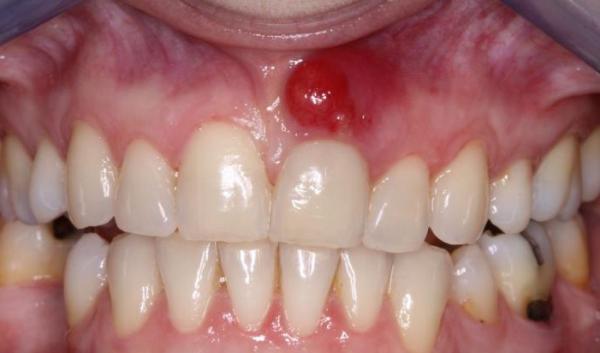 In complicated cases, accompanied by extensive tissue damage and a serious inflammatory process, an additional course of antibiotics may be prescribed.
In complicated cases, accompanied by extensive tissue damage and a serious inflammatory process, an additional course of antibiotics may be prescribed.
Usually, these are drugs in tablets or solutions for intramuscular injections. The antibiotic stops the inflammatory process and destroys bacteria in a short time..
The type of antibiotic should be determined only by a doctor. When choosing the most effective drug the cause of the fistula, the extent of inflammation, the rate of development of the disease, and other parameters are taken into account.
Therefore, you should not self-prescribe antibiotics. There may be no benefit, but harm to the body will be done.
Most often, preference is given to Gentamicin in ampoules and preparations that have this component in their composition. The course of treatment with tablets is from seven to ten days, and two ampoules administered within one week may be sufficient for Gentamicin.
Here is a small list of antibiotics that are used in dentistry in the treatment of such inflammatory processes:
- Amoxiclav;
- doxycycline;
- Trichopolum;
- Amoxicillin;
- Flemoxin Solutab.
Each of these drugs has a number side effects, among which individual intolerance drug components. If the patient has had any previous allergic reaction to medications, it is necessary to inform the doctor about this before he makes an appointment.
Rehabilitation in the clinic
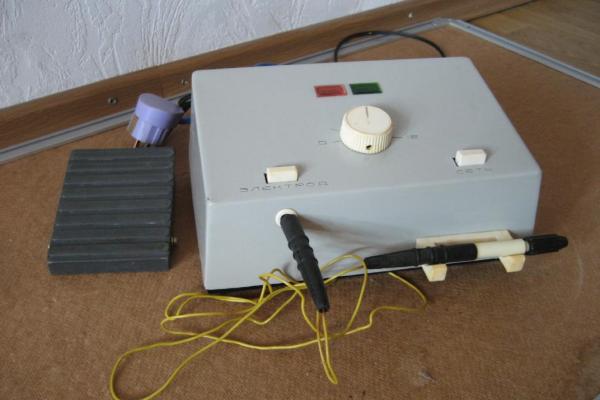
Photo: dental diathermocoagulator
If you delay the treatment of the fistula, then damage to neighboring tissues may begin. In severe cases, the fistula can spread to adjacent cheek tissues.
After a course of antibiotic treatment and antimicrobials, as well as eliminating the cause of the fistula, may be required rehabilitation measures for tissue repair.
For more fast healing the affected areas of the gums are treated with laser tissue treatment. During this procedure, wounds on the gums and cheeks are cauterized with a laser, which stops possible bleeding.
The same effect is exerted by cauterization of tissue sections with a diametric current or in a different way. diathermocoagulation. Some patients are very sensitive to the effects of current pulses and this method of rehabilitation cannot be applied to them.
Another modern method used to restore the structure of tissues after a fistula is ultrasonic impact. With its help, tissue regeneration is accelerated, and healing is much faster.
All these techniques are carried out in a dental clinic or physiotherapy room.
What can be done at home?
Some therapeutic actions, aimed at eliminating the fistula and the consequences of its occurrence, can be done at home. From medications effective antimicrobial and anti-inflammatory agents.
Contribute to faster tightening of the fistulous passage regular saline rinses prepared independently, or specially designed pharmacy solutions: Chlorhexidine or Betadine.
Special gels with antimicrobial and antiseptic action can also positively affect the healing of the fistula. Among them are used Solcoseryl, Asepta, Metrogil Denta.
At severe pain you can sometimes use cooling gels designed to remove pain syndrome in children with teething or analgesics.
It must be remembered that it is impossible to cure a fistula at home without consulting a dentist. If you do not eliminate the cause, then the problem will return. Therefore, all treatment should be agreed with the attending physician.
The use of folk remedies

Many recipes for the treatment of fistula are also in folk medicine. Some consider them safer, but you should always be aware of possible allergic reactions on herbs.
In conjunction with traditional treatment successfully used:
- herbal infusions and decoctions for rinsing;
- medicinal ointments and balms;
- various lotions.
Can be used to relieve inflammation decoction. For its preparation, take in equal parts dandelion, yarrow, tansy and calendula. One tablespoon of the finished mixture is brewed with boiling water, and when the broth has cooled to a comfortable temperature, you can rinse your mouth.
The herbs that make up the decoction have a strong anti-inflammatory effect and a healing effect.
Another popular remedy is considered to be a healing ointment, which in its composition has many medicinal plants. To prepare an ointment for two parts of the flowers and leaves of yarrow, calendula flowers and dandelion root, take one part of the inflorescences and herbs of tansy, garden sorrel root, sweet clover grass.
All plants need to be ground in a meat grinder or grinder, and then add one part to them ichthyol ointment or Vishnevsky liniment. If the resulting mass is not homogeneous, you can add a little calendula oil. The resulting ointment is infused for 12 hours, and then smeared on the affected gum.
To pull out pus from the fistulous passage will help cooked with your own hands. eucalyptus ointment. About forty grams of eucalyptus must be combined with a tablespoon of sunflower oil and insisted for a day. Then chopped onion is added to the mixture.
The mixture wrapped in a gauze bag is applied once a day to the damaged area. You should be careful, as eucalyptus can cause irritation and sores. In this case, the amount of eucalyptus in the mixture should be halved.
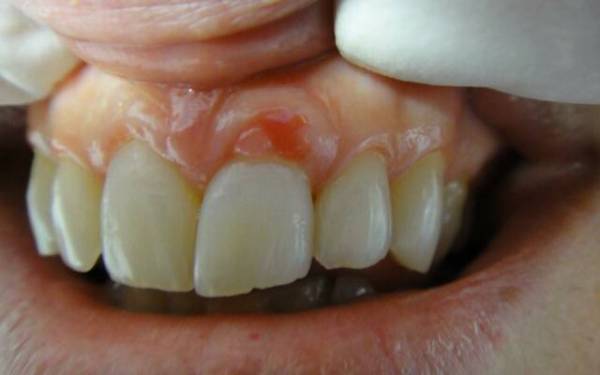 Another recipe for healing lotion can speed up the healing of the fistulous passage. To the crushed leaves of aloe and Kalanchoe (three pieces each), add a few cloves of finely chopped garlic.
Another recipe for healing lotion can speed up the healing of the fistulous passage. To the crushed leaves of aloe and Kalanchoe (three pieces each), add a few cloves of finely chopped garlic.
The resulting slurry is wrapped in gauze or bandage and applied to the affected gum for ten minutes. If you hold the lotion for too long, burning and irritation may occur.
Admirers of traditional medicine should remember that the listed recipes are effective only as aids to speed up recovery. But don't just rely on healing properties plants, because in order to cure, you must first eliminate the cause of the fistula.
Features of therapy in a child
A fistula in a child is a very dangerous dental problem. Therefore, its untimely treatment or attempts to cope with the fistula on their own can lead to unpleasant complications.
At the first signs of fistula formation in a child, you should immediately contact pediatric dentist . Save baby tooth does not make sense, so it is better to remove it immediately to save the baby from pain.
After the removal of the diseased tooth, the inflammatory process must be removed. For this, external agents are more often used, for example, the affected part of the gum is lubricated with an ointment with an antibiotic in the composition.
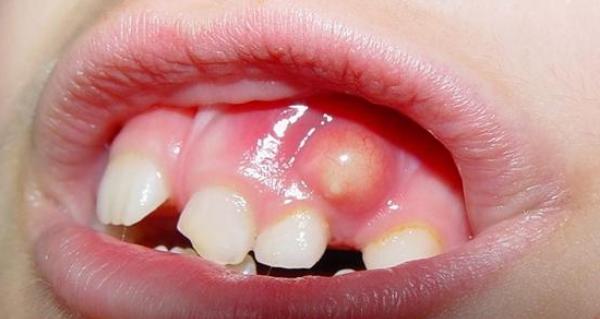
Internal antibiotics can be prescribed only for extensive lesions. bacterial infection which can only be confirmed by laboratory tests.
If your child already knows how to brush their own teeth, then you can resort to rinsing with saline. But leaving the child alone during the procedure is not worth it in order to avoid accidentally swallowing the solution along with the pus that has got into it.
You should not start the course of the disease in either children or adults, then treatment will pass fast. You can avoid the recurrence of the fistula by observing the rules of oral hygiene and timely treatment problems with teeth and gums.
If you find an error, please highlight a piece of text and click Ctrl+Enter.





